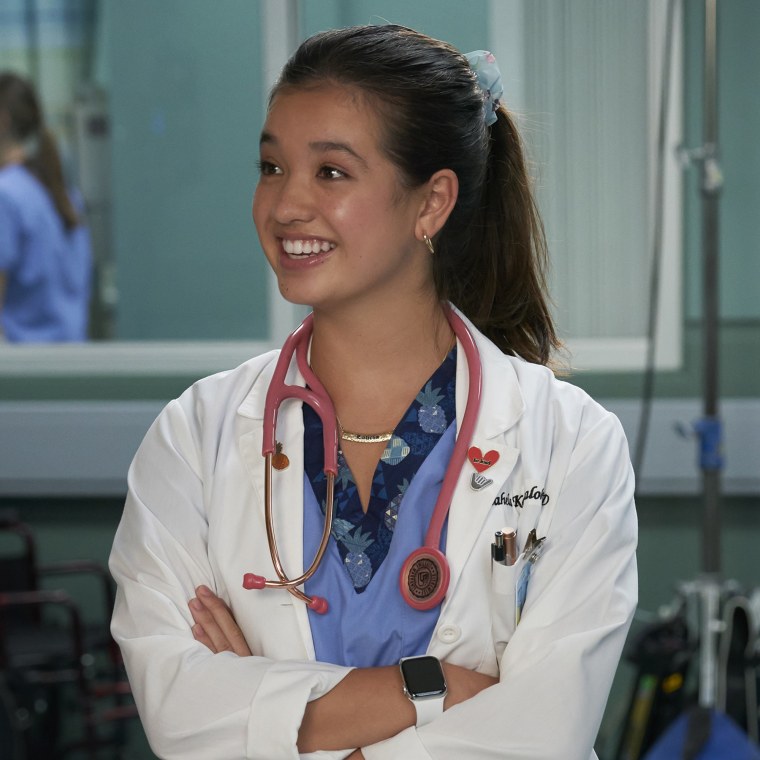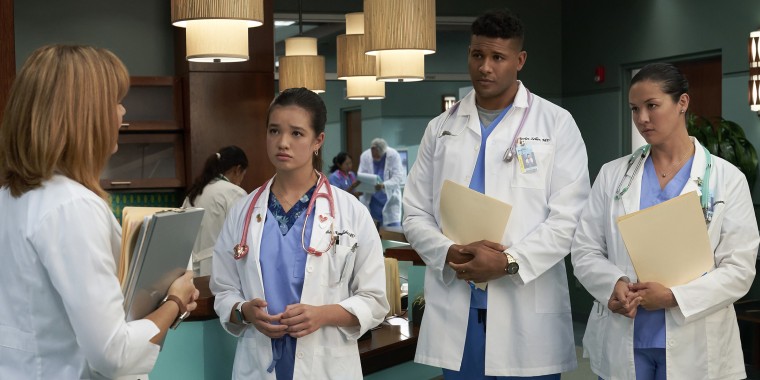More than three decades after Neil Patrick Harris rose to fame on the hit ABC medical drama “Doogie Howser, M.D.,” Peyton Elizabeth Lee has stepped into the lead role of a wunderkind physician in the reimagined Disney+ series “Doogie Kameāloha, M.D.”
Created by Kourtney Kang (“How I Met Your Mother,” “Fresh Off the Boat”), the gender-flipped reboot, which premiered Wednesday, centers on Lahela Kameāloha (Lee), a 16-year-old Native Hawaiian prodigy who is juggling a burgeoning medical career and unconventional life as a teenager in present-day Hawaii.
Last fall, a year after finishing her three-season run as the title character in the groundbreaking Disney Channel series “Andi Mack,” Lee was searching for her next project when the audition for a “Doogie” reboot — which was being reimagined with a mixed-race, female lead — arrived in her inbox.
“I remember really feeling like [it was] a light at the end of the tunnel,” Lee, 17, told NBC Asian America. “This was the first thing that I had been super excited about and inspired by in a long time.”

After booking the role, Lee said she used a combination of her own lived experience as a middle child in a mixed-race, Chinese and white family and her extensive conversations with Kang, who produced a show that is “very much a reflection of her family and her own experience,” to develop her approach to playing Lahela. But Lee felt it was equally important for audiences to buy into the idea of a high-achieving, teenage doctor, which required a lot of preparatory research and on-set work with a medical consultant.
“The medical jargon is no joke,” Lee, who is a superfan of “Grey’s Anatomy,” said with a laugh. “It’s not only saying these words, but saying them in a way that makes it seem like you say them all the time and know what you’re saying. … So any time we were shooting medical scenes, we would drill lines, go through procedures and talk through not only what I was saying but what [it] meant.”
While she joked that “Doogie Howser, M.D.,” which premiered in 1989, was a little before her time, Lee credited Kang for creating a new iteration that both modernizes and pays homage to its predecessor and crafting a protagonist whose journey “is very universal to the human experience of growing up” and resonates closely with her own experience as a child actor.
“I think I have a very unique insight into what it is like to be a young person in a professional environment and having these adult expectations and responsibilities being placed on you,” Lee said. “When is it the time to just be an adult, show up to work and meet everyone on their level? And when is it time to create space and be a kid? Getting to bring that part of my experience to this show, I think, adds a lot of authenticity.”
For Lee, who said she’s gone on numerous Hollywood auditions “for the smart girl, the girl who plays the violin and the girl who’s really good at math,” that authenticity was paramount to creating a character that did not fall straight into the studious Asian stereotype.
While Lahela is “obviously very brilliant and smart and loves learning,” Lee said, she is “also just like any other teenage girl” with her own crushes, issues with friends and complicated family dynamics. (Lahela’s mother, Dr. Clara Hannon, played by Kathleen Rose Perkins, is also her boss, leading to a complicated work-life balance in the series.)
“So as much as [being a doctor] is a part of her, it doesn’t define her entirely,” Lee said. “I think it’s important that just because we don’t want to fit into these stereotypes doesn’t mean that Asian people can’t be smart on TV. We don’t have to fight against it just to fight against it. But it’s more about recognizing that we can be [more than] that, on top of all the other things that we are.”
From the time she landed her role on “Andi Mack” at age 12, Lee came to understand the importance of playing characters who she feels are strong role models for younger audiences, particularly for young girls of color.
“Being who I am and looking the way I look, there is this added level of responsibility when it comes to that and the representation in media,” she said. “I think sometimes it’s underestimated, but there is a very significant feeling of empowerment that comes when you see someone that looks like you or that you relate to doing something that you want to do.”
Following the groundbreaking success of “Crazy Rich Asians,” which opened her eyes to the possibility of having multiple Asian romantic leads and Asian artists “guiding and telling their own story,” Lee said that “it means everything to me to be a part of that new wave of representation and contributing to that feeling of inclusivity and diversity.”
While this new iteration of “Doogie” is a better reflection of life in the 21st century, the producers have also been criticized for casting a non-Native Hawaiian actor in the title role. As a “proponent of people being able to tell their own stories” in the current social climate, Lee — whose father is Chinese and mother is Irish Italian — said she feels that while “that criticism is valid,” she still did everything she could to learn about the cultural nuances of growing up and living in Hawaii, where the cast and crew shot the 10-episode first season.
“I worked to get a better, broader, more authentic understanding of what that would be like and how that would affect a person — and all of the incredible ways that it enriches Lahela’s life,” Lee said.
After speaking with Kang (who was born in Hawaii), her on-screen father, Jason Scott Lee (who was raised in Hawaii), and her on-screen older brother, Matthew Sato (who is Hawaiian), Lee said she was able to bring layers of her own experience of “not being Hawaiian but being in the Asian American Pacific Islander community and being biracial.” While there might be obvious cultural differences, Lee said she thinks a “lot of my experience translates and transcends specific nationality.”
“Just having these people on screen that reflect real life — because movies and TV shows should be a reflection of the real world, and in the real world, there are people of all colors and shapes and sizes — is so important,” Lee said. “And hopefully with our show, and with telling this story of this Hawaiian, biracial family, we are carving out just a little more space for people to tell their own, authentic stories.”
The first episode of “Doogie Kameāloha, M.D.” is now streaming on Disney+, with each of the remaining nine episodes to be released on Wednesdays.
This story first appeared on NBCNews.com.


